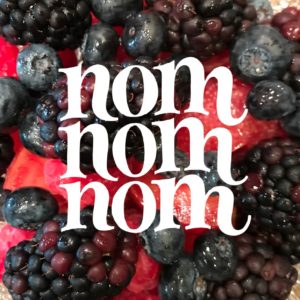 Dr. Joel Fuhrman (President of the Nutritional Research Foundation, frequent guest on the Dr. Oz Show, and former competitive figure skater) coined the Health Equation: Health = Nutrients / Calories, abbreviated as H = N/C. Some of you might be wondering “How is this equation relevant to me and my health?” That’s a good question, I’m glad you asked! It means you should eat a high ratio of noncaloric nutrients (such as vitamins, minerals, fibers, etc) per calorie (carbohydrates, fats, and proteins) consumed. Let’s look at 2 caramel recipes (a traditional recipe and an alternative recipe that is equally delicious, but offers more nutrients) to demonstrate how the Health Equation can be applied in your life.
Dr. Joel Fuhrman (President of the Nutritional Research Foundation, frequent guest on the Dr. Oz Show, and former competitive figure skater) coined the Health Equation: Health = Nutrients / Calories, abbreviated as H = N/C. Some of you might be wondering “How is this equation relevant to me and my health?” That’s a good question, I’m glad you asked! It means you should eat a high ratio of noncaloric nutrients (such as vitamins, minerals, fibers, etc) per calorie (carbohydrates, fats, and proteins) consumed. Let’s look at 2 caramel recipes (a traditional recipe and an alternative recipe that is equally delicious, but offers more nutrients) to demonstrate how the Health Equation can be applied in your life.
Traditional caramel recipes include ingredients like:
- white sugar
- brown sugar
- corn syrup
- evaporated milk
- heavy whipping cream
- butter
- vanilla extract
In contrast, this caramel recipe includes:
- almond butter
- pure maple syrup
- coconut oil
- vanilla extract
- salt
Not only are the individual ingredients of the second caramel recipe less processed relative to those of the traditional caramel recipe, but as you’ll see below, they are also more nutrient dense (providing more nutrition per calorie consumed).
To demonstrate the concept of nutrient density let’s look at the sweeteners included in both caramel recipes. (Feel free to follow the hyperlinks which will direct you to nutritional information about each of the ingredients listed.) White sugar, brown sugar, and corn syrup are all used to make traditional caramel and contain minimal noncaloric nutrients such as vitamins and minerals. The small amount of minerals that are found in these sweeteners actually come from the molasses that is added to sugar to make brown sugar. In contrast, pure maple syrup (like the one used in the second caramel recipe) is loaded with minerals such as calcium, iron, zinc, potassium, and manganese. As you can see, choosing pure maple syrup as your sweetener of choice results in more noncaloric nutrient consumption (specifically minerals) than any of the other three alternatives mentioned.
Keep in mind that you can apply this concept to any foods you eat. If you’re unsure of the nutritional information for the foods you are eating, go to websites like nutritiondata.self.com and look them up! Remember, the foods you eat fuel your body (You are what you eat!). If you eat mainly processed foods, even if you don’t feel bad (yet), your cells aren’t functioning as efficiently as they could if your diet mainly consisted of minimally processed whole foods such as fruits, vegetables, beans, nuts, and seeds.
Let’s summarize: Blah blah blah. Blah blah. Blah blah blah blah. Blah blah. Blah…… 😛
Through purposeful planning you can eat the foods you love AND feel good about it (literally)!
Awesome!
Thank you for reading!
No one in their right mind would put mud in the gas tank of their car. Race car drivers put higher octane gas to get peak performance. That’s exactly what nutrition does for our bodies.
I like that analogy!
we are what we eat for sure. I am trying to eat better, staying away from processed foods…not eating things I can’t pronounce. Trying real hard to keep my carbs under 20 a day. That helps keep my Blood sugar under control. Keep up your posts Katie, you always inspire me…hugs
Thanks Murph. I’m happy to hear you are making a concerted effort to eat better. Keep up the good work! 🙂
Hi Katie,
So enjoy your posts! LOVE your humor!! Hope all is well…..
Thanks Goose! I’ll keep writing if you’ll keep reading!
I think this is a super simple explanation of the principle. What an interesting way to put it.
I wonder what “honey buns” look like in this equation. Lol
Great job babe! Keep em coming!
<3